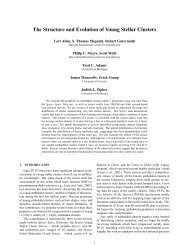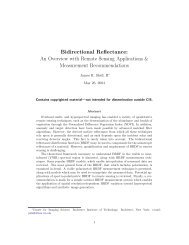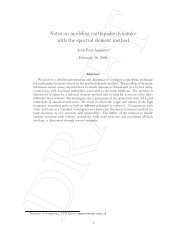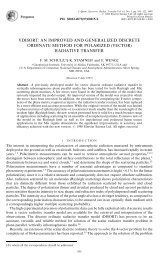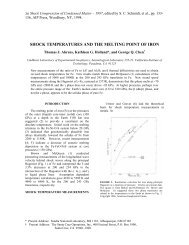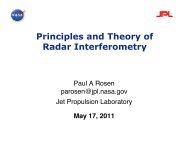for a 2-parameter Gamma-function size distribution with an effective radius of 1.05 µm, aneffective variance of 0.07 µm, and a refractive index of 1.43+ ???An additional test is performed to compare the results of <strong>VLIDORT</strong> with those found in Siewert(2000c). In this test and in that work, the optical property data set "Problem IIA" of Wauben andHovenier (1992) is used. This benchmark test considers a 1-layer "slab" problem with scatteringby randomly-oriented oblate spheroids with an aspect ratio of 1.999987, a size parameter of 3,and refractive index of 1.53-0.006i. The tables of results generated by <strong>VLIDORT</strong> for this casemay then be compared with Tables 2-9 of Siewert (2000c).6.3. BRDF SupplementHere, the bidirectional reflectance distribution function (BRDF) supplement is described. TheBRDF supplement is a separate system of <strong>VLIDORT</strong>-based software that has the purpose ofproviding total BRDF inputs for the main <strong>VLIDORT</strong> programs. In other words, we wish to fill upthe BRDF inputs in Tables C2 and G2 in sections 6.1.1.3 and 6.1.1.7, respectively. We note thatthe supplement also has the observational geometry facility like <strong>VLIDORT</strong> itself.In section 6.3.1, we give an overview of BRDF construction and discuss the available options.Next, a sample calling sequence for the supplement is given in section 6.3.2. The supplementinputs and outputs are given in tables in section 6.3.3. Following this, descriptions of the oceanand land kernels (both scalar and polarized) are given in sections 6.3.4-6.3.6. Lastly, the sectionis closed with some comments on surface emission in section 6.3.7.6.3.1. BRDFs as a sum of kernel functionsA scalar 3-kernel bidirectional reflectance distribution function (BRDF) scheme wasimplemented in LIDORT [Spurr, 2004]; a similar scheme is implemented in <strong>VLIDORT</strong>. Herewe confine ourselves to a scalar description. The BRDF ρ ( μ,μ′, φ − φ′total) is specified as alinear combination of (up to) three semi-empirical kernel functions:3∑ρ ′ − ′ =′ − ′total( μ,μ , φ φ ) Rkρk( μ,μ , φ φ ; bk) . (6.3.1)k = 1Here, ( θ , φ)indicates the pair of incident polar and azimuth angles, with the prime indicating thereflected angles. The R k are linear combination coefficients or “kernel amplitudes”, while thekernels ρk( θ,θ ′,φ − φ′; bk) are derived from semi-empirical models of surface reflection for avariety of surfaces. For each kernel, the geometrical dependence is known, but the kernelfunction depends on the values taken by a vector b k of pre-specified parameters.A well-known example is the single-kernel Cox-Munk BRDF for glitter reflectance from theocean [Cox and Munk, 1954a, 1954b]; the kernel is a combination of a Gaussian probabilitydistribution function for the square of the wave facet slope (a quantity depending on wind-speedW), and a Fresnel reflection function (depending on the air-water relative refractive index m rel ). Inthis case, vector b k has two elements: b k = {W, m rel }. For a Lambertian surface, there is onekernel: ρ 1 ≡ 1 for all angles, and coefficient R 1 is just the Lambertian albedo.104
In order to develop solutions in terms of a Fourier azimuth series, Fourier components of the totalBRDF are calculated through:2πm1ρ ′ = ∫ ρ μ μ′k( μ,μ ; bk)k( , , φ;bk) cos mφdφ. (6.3.2)2π0This integration over the azimuth angle from 0 to 2π is done by double numerical quadrature overthe ranges [0,π] and [−π,0]; the number of BRDF azimuth quadrature abscissa N BRDF is set to 50to obtain a numerical accuracy of 10 -4 for all kernels considered in [Spurr, 2004].Linearization of this BRDF scheme was reported in [Spurr, 2004], and a mechanism developedfor the generation of surface property weighting functions with respect to the kernel amplitudesR k and also to elements of the non-linear kernel parameters b k. It was shown that the entirediscrete ordinate solution is differentiable with respect to these surface properties, once we knowthe following kernel derivatives:∂ρ( θ,α,φ)∂ρ( θ,α,φ;b=totalk∂b p,k∂bp,k∂ρtotal( θ,α,φ)= ρk( θ,α,φ;bk)∂Rkk)(6.3.3)(6.3.4)The amplitude derivative is trivial. The parameter derivative (6.3.3) depends on the empiricalformulation of the kernel in question, but all kernels in the LIDORT and <strong>VLIDORT</strong> BRDFschemes are analytically differentiable with respect to their parameter dependencies.Table 6.3.1 The BRDF kernel functions for <strong>VLIDORT</strong>Index Name Size b k Reference Scalar/Vector1 Lambertian 0 Scalar2 Ross thin 0 Wanner et al., 1995 Scalar3 Ross thick 0 Wanner et al., 1995 Scalar4 Li sparse 2 Wanner et al., 1995 Scalar5 Li dense 2 Wanner et al., 1995 Scalar6 Hapke 3 Hapke, 1993 Scalar7 Roujean 0 Wanner et al., 1995 Scalar8 Rahman 3 Rahman et al., 1993 Scalar9 Cox-Munk 2 Cox/Munk, 1954 Scalar10 Giss Cox-Munk 2 Mishchenko/Travis 1997 Vector11 Giss Cox-Munk Cri 2 Natraj, 2010 (personal Vectorcommunication)12 BPDF 2009 2 Maignan et al., 2009] VectorThe <strong>VLIDORT</strong> BRDF supplement has 12 possible kernel functions, and these are listed in Table6.3.1 along with the number of non-linear parameters; the user can choose up to three from thislist. A full discussion of these kernel types is given in [Spurr, 2004]; a brief summary is given inthe later sections.105
- Page 1:
User’s GuideVLIDORTVersion 2.6Rob
- Page 5 and 6:
Table of Contents1H1. Introduction
- Page 7 and 8:
1. Introduction to VLIDORT1.1. Hist
- Page 9 and 10:
Table 1.1 Major features of LIDORT
- Page 11 and 12:
In 2006, R. Spurr was invited to co
- Page 13:
corrections, and sphericity correct
- Page 16 and 17:
Matrix Π relates scattering and in
- Page 18 and 19:
m⎛ P⎞l( μ)0 0 0⎜⎟mmm ⎜ 0
- Page 20 and 21:
In the following sections, we suppr
- Page 22 and 23:
of the single scatter albedo ω and
- Page 24 and 25:
Here T n−1 is the solar beam tran
- Page 26 and 27:
~ + ~ ~ (1)~ ~ + ~ ~ (2)~ ~ − ~ 1
- Page 28 and 29:
The solution proceeds first by the
- Page 30 and 31:
Linearizations. Derivatives of all
- Page 32 and 33:
For the plane-parallel case, we hav
- Page 34 and 35:
One of the features of the above ou
- Page 36 and 37:
L↑↑ ↑k (cot n −cotn −1)[
- Page 38 and 39:
Note the use of the profile-column
- Page 40 and 41:
βl,aer(1)(2)fz1e1βl+ ( 1−f ) z2
- Page 42 and 43:
For BRDF input, it is necessary for
- Page 44 and 45:
streams were used in the half space
- Page 46 and 47:
anded tri-diagonal matrix A contain
- Page 48 and 49:
in place to aid with the LU-decompo
- Page 50 and 51:
In earlier versions of LIDORT and V
- Page 53 and 54: 4. The VLIDORT 2.6 package4.1. Over
- Page 55 and 56: (discrete ordinates), so that dimen
- Page 57 and 58: Table 4.2 Summary of VLIDORT I/O Ty
- Page 59 and 60: Table 4.3. Module files in VLIDORT
- Page 61 and 62: Finally, modules vlidort_ls_correct
- Page 63 and 64: end program main_VLIDORT4.3.2. Conf
- Page 65 and 66: $(VLID_DEF_PATH)/vlidort_sup_brdf_d
- Page 67 and 68: Finally, the command to build the d
- Page 69 and 70: Here, “s” indicates you want to
- Page 71 and 72: The main difference between “vlid
- Page 73 and 74: to both VLIDORT and the given VSLEA
- Page 75 and 76: STATUS_INPUTREAD is equal to 4 (VLI
- Page 77 and 78: 5. ReferencesAnderson, E., Z. Bai,
- Page 79 and 80: Mishchenko, M.I., and L.D. Travis,
- Page 81: Stamnes K., S-C. Tsay, W. Wiscombe,
- Page 84 and 85: Table A2: Type Structure VLIDORT_Fi
- Page 86 and 87: DO_WRITE_FOURIER Logical (I) Flag f
- Page 88 and 89: USER_LEVELS (o) Real*8 (IO) Array o
- Page 90 and 91: angle s, Stokes parameter S, and di
- Page 92 and 93: DO_SLEAVE_WFS Logical (IO) Flag for
- Page 94 and 95: 6.1.1.8. VLIDORT linearized outputs
- Page 96 and 97: NFINELAYERS Integer Number of fine
- Page 98 and 99: 6.1.2.4. VLIDORT linearized modifie
- Page 100 and 101: The output file contains (for all 3
- Page 102 and 103: The first call is the baseline calc
- Page 106 and 107: Remark. In VLIDORT, the BRDF is a 4
- Page 108 and 109: 6.3.3.1. Input and output type stru
- Page 110 and 111: Table C: Type Structure VBRDF_LinSu
- Page 112 and 113: Special note regarding Cox-Munk typ
- Page 114 and 115: squared parameter, so that Jacobian
- Page 116 and 117: 6.4. SLEAVE SupplementHere, the sur
- Page 118 and 119: is possible to define Jacobians wit
- Page 120 and 121: etween 0 and 90 degrees.N_USER_OBSG
- Page 122: 6.4.4.2 SLEAVE configuration file c



